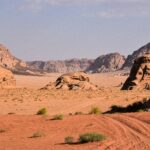![Visit Qumran Caves and National Park -Guide [2024] 6 Qumran Caves](https://artandthensome.com/wp-content/uploads/2023/05/pexels-bogdan-siudy-7161376-1024x683.jpg)
Qumran is situated in the northern part of the Judean Desert, just south of the city of Jericho, which is recognized as the oldest city in the world. The Qumran Caves, facing the Dead Sea, hold immense significance as the most revolutionary archaeological site for Bible studies in the 20th century.
This site, managed by Israel’s national parks organization,
It consists of two main sections: The first part, easily accessible, takes you to the heart of what was once the center of a Jewish subgroup known as the “community of Yahad.” The second part grants access to some of the caves where the valuable biblical manuscripts were discovered.
The history of this community, along with the intriguing circumstances surrounding the unearthing of the manuscripts, has been a subject of extensive discussion. Even after more than 70 years since their discovery, these findings continue to spark academic debates and pique the interest of the Judeo-Christian world.
Situated 20 km from Jericho, these caves housed the renowned Dead Sea Scrolls, which were written by the Essenes nearly 2,000 years ago and were only unearthed 50 years ago. The site itself is magnificent, and its history is truly exceptional.
Visiting The Caves of Qumran
![Visit Qumran Caves and National Park -Guide [2024] 7 Qumran National Park](https://artandthensome.com/wp-content/uploads/2023/05/pexels-peiqi-shi-13414980-1024x768.jpg)
Bring plenty of water, sunscreen and a hat as it is extremely hot at this site. Find out about access to the site because due to its border position it can be closed for security reasons.
The visit begins with an information center where you can watch the explanatory video on the manuscripts to fully understand what it is about. A total of 900 manuscripts were found in 11 caves. It’s really incredible that these manuscripts were discovered only 50 years ago and that they are so well preserved after spending 2000 years at the bottom of an airtight terracotta jar!
Hiking to the caves
![Visit Qumran Caves and National Park -Guide [2024] 8 Qumran Caves](https://artandthensome.com/wp-content/uploads/2023/05/pexels-samir-smier-13611801-1024x576.jpg)
The hiking itself is nice to climb to the top of the caves, but it can be really hot. The caves are really huge and the view of the Dead Sea is sublime. You can be also interested in visiting the ruined village of Essenes, which must be surveyed with a guide for good explanations.
Bit of history
You can see in particular objects excavated here and an aqueduct which was built by the Essenes to bring water to this very arid place where they lived withdrawn from the world for 300 years. The community was destroyed by the Romans in 68 BC. but they had time to hide the fruit of their incredible labor before they arrived.
FAQ on Qumran
What does Qumran mean?
This name, much later than the site, means in Arabic: Two Moons.
It apparently refers to the destabilizing vision on full moon evenings of the moon’s reflection in the waters of the Dead Sea, giving the disturbing impression of facing two moons, one celestial and the other terrestrial.
How could the scrolls of Qumran last almost 2200 years without being altered?
The scrolls from the Qumran caves were hastily but carefully hidden in fabrics buried in terracotta containers, themselves hidden in caves in the most seiche area of the country (30-90 mm of water per year).
The unique climatic conditions of this region have favored the good conservation of some of its rolls.
Who wrote the Dead Sea Scrolls?
Members of the Yahad community are essentially members of the legitimate priestly community (the High Priesthood).
The latter were forced to flee Jerusalem and the corruption of its Temple by the new class which will usurp the priestly and political authority by founding, after the troubles of the revolt of the Macabees, the very last Jewish dynasty, that of the Hasmonean priest-kings .
Do you have access to the Dead Sea Scrolls in Qumran?
The Dead Sea Scrolls are today divided between different museums.
Most of it remains contained within the Jerusalem Shrine of the Book, where some scrolls are on display to the public.
Another part of which the copper scroll is on display at the Jordanian Museum in Amman.
Scrolls on display at the Chicago Museum have turned out to be copies, a few traveling exhibits have presented scrolls to the general public in the past.
Today these scrolls have been digitized and translated and are freely accessible on the internet.
In what languages were the Dead Sea Scrolls written?
The Dead Sea Scrolls were written in three languages.
The major part of these rolls was written in Hebrew and Paleo-Hebraic characters, a lesser part in Aramaic, and a last part was written in Greek.





